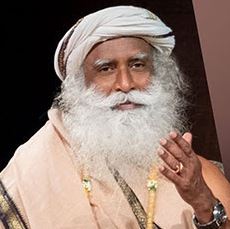The Ganesh Chaturthi festival is on 10 September, 2021. Sadhguru explains the significance and symbolism of this popular Indian festival, distilling the wisdom behind the ritual of visarjan (submerging the Ganesha idol) to make it relevant for today.
 Sadhguru: Shiva was a bit of a vagabond husband. He was constantly going off wherever his wanderings took him for long periods of many years. There were no cell phones and emails in those days, so when he went, Parvati had no contact with him at all. And she grew quite lonely. Moreover, because of the nature of who Shiva was – he was considered yaksha swarupa or not of human origin – Parvati could not bear his child.
Sadhguru: Shiva was a bit of a vagabond husband. He was constantly going off wherever his wanderings took him for long periods of many years. There were no cell phones and emails in those days, so when he went, Parvati had no contact with him at all. And she grew quite lonely. Moreover, because of the nature of who Shiva was – he was considered yaksha swarupa or not of human origin – Parvati could not bear his child.
So, out of her loneliness and her desire and maternal instinct, she decided to create and breathe life into a baby. She took something of herself, the sandal paste that was on her body, mixed it with the local soil, made it in the form of a baby and breathed life into it. This may look far-fetched, but today science is talking in these terms. If someone were to take an epithelial cell from you, some day we could make something of you out of it. Parvati breathed life into it, and a little boy was born.
Why Shiva Cut Ganesha’s Head
A few years later, when the boy was about ten years of age, Shiva returned with his ganas. Parvati was having a bath, and she had told the little boy, “Make sure no one comes this way.” The boy had never seen Shiva, so when he came, the boy stopped him. Shiva was in one of those moods – not willing to be stopped – so he just took his sword out, took the boy’s head off and came to Parvati.
When Parvati saw the bloody sword in his hand, she knew what happened. She saw the boy lying there headless and flew into a rage. Shiva tried to convince her, “It is okay. He is not really your son. After all, you made him up and I closed him. So what is the problem?” But she was in no mood to listen.
Why Ganesha Does Not Have an Elephant Head
To settle the issue, Shiva took the head of one of the ganas and put it on the boy. Ganesh Chaturthi is the day this head transplant happened. Because he took the head off the leader of the ganas and put it on this boy, he said, “From now, you are a Ganapati. You are the head of ganas.” Somewhere down the line, calendar artists could not understand what this other creature was, and drew an elephant face. The lore talks about how the ganas had limbs without bones. In this culture, a limb without bones meant an elephant trunk, so artists made it into an elephant head. You are not going to find an elephant on the banks of Manasarovar because the terrain is not right. There is not enough vegetation for an elephant. Shiva could not have gone about chopping elephants. So, he is many things – Ganesha, Ganapati, Vinayaka – but not Gajapati.
The ganas were the companions of Shiva. We do not know where they came from, but generally the lore describes them as beings who do not belong to this planet. The texture of that life is very different from how we know life here.
Today, modern biology is very clear about what a phenomenal transformation it is from a single-celled animal, to all the more complex forms of life, to what a human being is. But the fundamental nature of life is the same – it has not changed. It is just getting more complex. However, the ganas were not of the same texture of life. They were not made on Earth. And they had limbs without bones.
If you try to use your body in a variety of ways, if you attempt asanas, you would wish you had no bones. I started my Yoga when I was just 11, so when I taught Hatha Yoga when I was 25, people looked at me and said, “Oh, you do not have bones. You are boneless.” This is a dream of every Yogi: that someday he will have limbs without bones so that he can do any asana he wants!
The Well-Fed Scholar
For thousands of years, Ganesh Chaturthi has lived on, and Ganapati has become one of the most popular and most exported gods from India. He is very flexible. He takes on many forms and poses. He is also the god of learning. He was supposed to be a brilliant scholar. Ganapati is always shown with a book and a pen, to show his scholarly capabilities. His scholarship and intellect was beyond normal human capabilities.
And he liked food. Usually, if someone has to look scholarly, he has to look skinny. But this is a nice, well-fed scholar. On this day, people generally believe that all you are supposed to do is eat well. People saw only the big belly, but missed the much bigger brain in the new head. That is the most important thing. His belly grew later. Maybe with such a big head, he did not feel like taking a walk! But the important thing is that his intelligence multiplied. So this is not just a day for eating. This is a day when you must multiply your brains, not your belly.
The Significance of Ganesh Chaturthi
Humanity has always made the serious mistake of working towards producing good people. We do not need good people; we need sensible people. If you have sense, you will do the right thing. People do idiotic things only because they do not have sense.
Intelligence is not shrewdness. Intelligence is not about being clever. If you are truly intelligent, you would be 100% in tune with the existence because there is no other way to be intelligent. The sign of intelligence is that you are absolutely in tune with everything around you, you are going through life with the least amount of aberration within and outside of you.
Ganesh Chaturthi is a day to at least start striving to multiply your intelligence. If you work for a boneless limb by doing asanas in the morning,it may happen!
(Courtesy: ISHA)

Readers like you, make ESHADOOT work possible. We need your support to deliver quality and positive news about India and Indian diaspora - and to keep it open for everyone. Your support is essential to continue our efforts. Every contribution, however big or small, is so valuable for our future.











